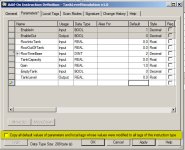Dan123
Member
When using AOIs in RSLogix 5000, how can I make changes to certain settings be applied to all instances of the AOI? For example, I create 20 instances of an AOI that has a local timer with a preset of 1000ms. Later on, I would like to change that preset to 5000ms, so I go offline, change the preset value in the definition of the AOI to 5000ms, and download the project to the PLC. However, when I do this, all the timers in the instances remain at the original setting of 1000ms!
This is happening for all my local variables inside AOIs -- all the instances used the initial value I set in the definition, and any time I make a change to the definition they are not applied to the instances.
This is happening for all my local variables inside AOIs -- all the instances used the initial value I set in the definition, and any time I make a change to the definition they are not applied to the instances.




